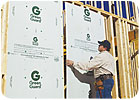
This month, we’ll conclude the year and our series all about sheathing. In past installments of this series, we looked at the purpose, environmental aspects and types of sheathing products including:
- Wood-based
- Gypsum-based
- Cement-based
Foam follows function
Introduced in the ’70s as part of the reaction to the energy crisis brought on by the 1973 OPEC oil embargo, plastic/foam insulation was/is used primarily for its high R-values (thermal resistance). For example, EIFS include petrochemical based EPS/XPS (expanded polystyrene) foam insulation, which increases a building envelope’s energy efficiency up to 28 percent. In the early days, plastic/foam insulation was made with chlorofluoro carbons and hydrochlorofluoro carbons. They proved problematic contributing significantly to atmospheric ozone depletion through off gassing. Nowadays, most CFCs and HCFCs have been eliminated from plastic/foam insulation.Plastic/foam-based sheathing is a lightweight panel made from either polystyrene or polyisocyanurate. Neither type provides any structural capacity (i.e. “racking resistance”) unless they are heavily reinforced. Polystyrene is more appropriate for wet environments, whereas polyisocyanurate will degrade when exposed to moisture.
Because of its moisture vulnerability, polyisocyanurate is covered with a foil skin for moisture protection and effectively acts as a vapor retarder in much the same way foil-back gypsum wallboard does. As such, caution should be exercised when incorporating polyisocyanurate sheathing in an exterior wall assembly where there may be another vapor retarder, such as 6-mil polyethylene, foil-back gypsum wallboard, foil-faced fiberglass insulation, etc.
Use of plastic/foam sheathing is the primary method for mitigating the thermal penalty when light gauge metal framing is used for exterior wall assemblies. Known as thermal bridging, as a conductor metal has roughly half the R-value of wood that has insulating abilities. The use of insulating sheathing (i.e. foam) directly over framing or another (primary) sheathing (i.e. plywood) is an effective way of increasing the energy efficiency of a LGMF exterior wall assembly by up to 23 percent. Another mitigator of thermal bridging is the greater spacing of LGMF (24 inches o.c. typically) rather than the 16 inches o.c. typical for wood framing. This reduces by one-third the transmission points in the exterior wall (see past article “Let’s Get More Familiar (Part Four)”).
The contender
Pactiv Corp. (www.pactiv.com), a company involved with advanced packaging technologies, has introduced into its GreenGuard family (www.green-guard.com) of XPS insulation board products for both residential and commercial applications an extruded polystyrene foam core sheathing product meant to compete directly with OSB when used in non-structural applications.Known as GreenGuard PlyGood-Ultra Sheathing, it has four times the R-value-R-1.5 (at 3/8 inch thick) and R-1.8 (at 7/16 inch thick)-than non-insulating OSB. When 7/16-inch OSB is used for corner bracing, 7/16-inch PlyGood-Ultra butts into it cleanly, providing a smooth transition for the application of exterior finishes. The product is marketed through building material distributors and is available in 4-feet-wide-by-8-feet and/or 9-feet long panel sizes and, like other GreenGuard products, offers custom printing on the face of the panels for onsite brand identification.
The XPS foam core is made of closed-cell construction with a tough, strong, reinforced polyolefin scrim facer across the front of each board. This provides excellent moisture resistance and the product can be safely stored outside onsite where it will not swell or warp. At both 3/8 and 7/16 inches thick, water vapor transmission (vapor permeability) was 1.0 perms. The tough reinforced scrim facer resists puncture damage and helps prevent stapler blow-through.
At plus or minus 3 pounds for the 3/8-inch panels and plus or minus 4 pounds for the 7/16-inch panels, the sheathing is lightweight and easy to install. Pneumatic staples or roofing nails suffice for attachment to a substrate due to the special laminated surface on the product. Cap nails are not required for installation and can be cut with a utility knife. When tested, it withstood 110-plus mph wind conditions.
XPS is a non-structural sheathing. Like all plastic/foam-based sheathing, supplementary bracing (i.e. corners) is required. Besides the GreenGuard insulation board products used for wall sheathing, commercial roofing, below grade, basement and crawl space insulation, Pactiv also makes housewraps including:
- RainDrop
- Classic Wrap
- Ultra Wrap
- Value Wrap
The company also offers fanfold underlayment and roof and below-grade products, such as PB6 roofing recovery board, PB4 waterproofing protection board and CB4 condensation board.
With continuing innovations from manufacturers and next-generation products such as PlyGood-Ultra, Fiberock Aqua-Tough, GlasRoc, StructGuard TS, and others, the sheathing industry remains dynamic and in-tune with the needs of designers and end-users. In particular, the growing acceptance of green building practices such as minimizing volatile organic compounds, use of recycled materials and agricultural waste products bodes well for the green future of sheathing.





